- Home
- William Kennedy
Very Old Bones
Very Old Bones Read online
Praise for William Kennedy:
“Kennedy is a writer with something to say, about matters that touch us all, and he says it with uncommon artistry”
Washington Post
“Kennedy’s power is such that the reader will follow him almost anywhere, to the edge of tragedy and back again to redemption”
Wall Street Journal
“Kennedy’s art is an eccentric triumph, a quirky, risk-taking imagination at play upon the solid paving stones, the breweries, the politicos and pool sharks of an all-too-actual city”
The New York Review of Books
“His smart, sassy dialogue conveys volumes about character. His scene setting makes the city throb with life”
Newsday
“What James Joyce did for Dublin and Saul Bellow did for Chicago, William Kennedy has done for Albany, New York: created a rich and vivid world invisible to the ordinary eye”
Vanity Fair
“His beguiling yarns are the kind of family myths embellished and retold across a kitchen table late at night, whiskified, raunchy, darkly funny”
Time
“William Kennedy’s Albany Cycle is one of the great achievements of modern American writing”
Daily Mail
“William Kennedy is pre-eminent among his generation of writers . . . Kennedy is peerless in the depth and acuity of his sustained vision, and the lost, past world of Albany says more to us today about the current state, about the heart and soul, of American politics than any recent bestselling, Hollywood-pandering political thriller has ever done”
Spectator
“Kennedy’s writing is a triumph: he tackles topics in a gloriously comic, almost old-fashioned language. You feel Kennedy could write the Albany phone book and make it utterly entertaining”
Time Out
“Kennedy proves to be truly Shakespearean”
The Sunday Times
“Kennedy is one of our necessary writers”
GQ
ALSO BY WILLIAM KENNEDY
FICTION
The Ink Truck
Legs
Billy Phelan’s Greatest Game
Ironweed
Quinn’s Book
The Flaming Corsage
Roscoe
Changó’s Beads and Two-Tone Shoes
NONFICTION
O Albany!
Riding the Yellow Trolley Car
WITH BRENDAN KENNEDY
Charlie Malarkey and the Belly-Button Machine
Charley Malarkey and the Singing Moose
First published in the USA by Viking Penguin Inc.,
a division of Penguin Books USA 1992
This ebook edition published by Simon & Schuster UK Ltd, 2011
A CBS COMPANY
Copyright © WJK, Inc. 1992
This book is copyright under the Berne Convention.
No reproduction without permission.
All rights reserved.
The right of William Kennedy to be identified as author of this work has been asserted in accordance with sections 77 and 78 of the Copyright, Designs and Patents Act, 1988.
Simon & Schuster UK Ltd
1st Floor
222 Gray’s Inn Road
London WC1X 8HB
www.simonandschuster.co.uk
Simon & Schuster Australia Sydney
Simon & Schuster India Delhi
A CIP catalogue record for this book is available from the British Library
ISBN: 978-1-84983-852-8
eBook ISBN: 978-1-84983-853-5
This book is a work of fiction. Names, characters, places and incidents are either a product of the author’s imagination or are used fictitiously. Any resemblance to actual people living or dead, events or locales is entirely coincidental.
All reasonable effort had been made to contact the copyright holders of text used in this book. Any copyright holders not contacted should write to Simon & Schuster UK.
Typeset by Hewer Text UK Ltd
Printed and bound by CPI Group (UK) Ltd, Croydon CRO 4YY
This book is dedicated to the Hard Core (they know who they are), and to certain revered and not-so-revered ancestors of the author (they don’t know who they are, for they are dead; but they’d know if they ever got their hands on this book).
Any one who has common sense will remember that the bewilderments of the eyes are of two kinds, and arise from two causes, either from coming out of the light or from going into the light . . . and he who remembers this when he sees any one whose vision is perplexed and weak, will not be too ready to laugh; he will first ask whether that soul of man has come out of the brighter life, and is unable to see because unaccustomed to the dark, or having turned from darkness to the day is dazzled by excess of light.
—Plato
The Republic
CONTENTS
Book One
One
Two
Three
Four
Book Two
One
Two
Three
Four
Book Three
One
Two
Three
Four
Book Four
One
Two
Three
Four
Book Five
One
It is Saturday, July twenty-sixth, 1958, the sun will rise in about twenty-five minutes, the air is still, and even the birds are not yet awake on Colonie Street. There is no traffic on North Pearl Street, half a block to the east, except for the occasional auto, police prowl car, or the Second Avenue bus marking its hourly trail. A moment ago fire sirens sounded on upper Arbor Hill, to the west, their wail carrying down on the silent air, interrupting the dreams of the two sleeping occupants of this house, Peter Phelan, a seventy-one-year-old artist, and his putative son, Orson Purcell, a thirty-four-year-old bastard.
“Orson,” Peter called out, “where are those sirens?”
“Not around here,” I said.
“Good.”
He knew as well as I that the sirens weren’t close. His hearing was excellent. But he was reassuring himself that in case of fire Orson was standing by; for I was now the organizer of his life (not his art; he was in full command of that), the putative son having become father to the putative father. His health was precarious, a serious heart condition that might take him out at any instant; and so he abdicated all responsibility for survival and gave himself utterly to his work. I could now hear him moving, sitting up on the side of the bed in his boxer shorts, reaching for the light and for his cane, shoving his feet into his slippers, readying himself to enter his studio and, by the first light of new morning, address his work-in-progress, a large painting he called The Burial.
I knew my sleep was at an end on this day, and as I brought myself into consciousness I recapitulated what I could remember of my vanishing dream: Peter in a gymnasium where a team of doctors had just operated on him and were off to the right conferring about the results, while the patient lay on the operating table, only half there. The operation had consisted of sawing parts off Peter, the several cuts made at the hip line (his arthritic hips were his enemy), as steaks are cut off a loin. These steaks lay in a pile at the end of Peter’s table. He was in some pain and chattering to me in an unintelligible language. I reattached the most recent cut of steak to his lower extremity, and it fit perfectly in its former location. But when I let go of it it fell back atop its fellows. Peter did not seem to notice either my effort or its failure.
“Are you going to have coffee, Orson?” he called out from his room. In other words, are you going to make my breakfast?
“I am,” I said. “Couple of minutes.” And I snapped on the light and sat up from
the bed, naked, sweating in the grotesque heat of the morning. I put on a light robe and slippers and went down the front stairs and retrieved the morning Times-Union from the front porch. Eisenhower sending marines into Lebanon for mid-east crisis. Thunderstorms expected today. Rockefeller front runner for Republican nomination for Governor.
I put the paper on the dining-room table, filled the percolator, put out coffee cups and bread plates, and began plotting the day ahead, a day of significance to the family that had occupied this house since the last century. We would be gathering, the surviving Phelans and I, at the request of Peter, who was obeying a patriarchal whim that he hoped would redirect everybody’s life. My principal unfinished task, apart from ridding the house of clutter, was to inveigle my cousin Billy to attend the gathering here, a place he loathed.
I first came here in 1934 for a funeral. Peter passed me off as the son of his landlady, Claire Purcell (which I was and am), whom he had never brought to this house even for tea, though he had been living with her then in Greenwich Village for more than fifteen years. I liked Albany, liked the relatives, especially my Aunt Molly, who became my nurse after I went crazy for the second time, and I liked Billy, who always tried to tell the truth about himself, a dangerous but admirable trait. I went to college in Albany before and after the war and came here for dinner now and again, slowly getting to know this ancestral place and its inhabitants: the Phelans and the McIlhennys, their loves, their work, their disasters.
I came to see how disaster does not always enter the house with thunder, high winds, and a splitting of the earth. Sometimes it burrows under the foundation and, like a field mouse on tiptoe, and at its own deliberate speed, gnaws away the entire substructure. One needs time to see this happening, of course, and eventually I had plenty of that.
Colonie Street in Arbor Hill was the neighborhood where these people had implanted their lives in the last century. The first Phelans arrived from Ireland in the 1820s to finish digging the Erie Canal and by mid-century were laborers, lumbermen, railroad men, and homemakers of modestly expanding means. The McIlhennys came in the late 1870s, poor as turkeys and twice as wild.
Michael Phelan inherited twenty-one thousand dollars upon the death of his father, a junior partner in a lumber mill, and in 1879 Michael built this house for his bride, Kathryn McIlhenny, creating what then seemed a landmark mansion (it was hardly that) on a nearly empty block: two parlors, a dining room, and seven bedrooms, those bedrooms an anticipatory act of notable faith and irony, for, after several years of marriage, Kathryn began behaving like an all-but-frigid woman. In spite of this, the pair filled the bedrooms with four sons and three daughters, the seven coming to represent, in my mind, Michael Phelan’s warm-blooded perseverance in the embrace of ice.
The siblings were Peter and Molly; the long-absent Francis; the elder sister, Sarah; the dead sister, Julia; the failed priest, Chick; and the holy moron, Tommy. Peter had fled the house in the spring of 1913, vowing never to live here again. But the family insinuated itself back into his life after a death in the family, and he came home to care for the remnant kin, Molly and Tommy.
Peter’s pencil sketches of his parents and siblings (but none of his putative son) populated the walls of the downstairs rooms in places Peter thought appropriate: Francis in his baseball uniform when he played for Washington, hanging beside the china closet, the scene of a major crisis in his life; Julia in her bathing costume, standing in the ankle-deep ocean at Atlantic City, where her mother took her to spend two months of the summer of 1909, hoping to hasten her recovery from rheumatic fever with sea air, this sketch hanging over the player piano; Sarah, without pince-nez, in high-necked white blouse, looking not pretty, for that wasn’t possible for the willfully plain Sarah, but with an appealing benevolence that Peter saw in her, this sketch hanging on the east wall of the front parlor, close to the bric-a-brac Sarah had accumulated through the years, the only non-practical gifts the family ever gave her; for her horizon of pleasure in anything but the pragmatic was extremely limited. Molly hung in the back parlor also, with one foot on the running board of her new 1937 Dodge, looking very avant-garde for that year.
Peter sketched Chick at sixteen, in the black suit, Panama hat, and priestly collar he wore in the seminary, and hung the sketch in the front hallway, next to the autographed photo of Bishop T. M. A. Burke, former pastor of St. Joseph’s, whose sermon in 1900, on the fortieth anniversary of the church, inspired the fourteen-year-old Chick to devote his already pious life unreservedly to God. The parental sketches hung between the two windows of the dining room: Kathryn in the laundry of St. Peter’s Hospital on Broadway, which she worked in as a girl, then supervised for three years until the birth of Peter, after which she never worked; and Michael in his coveralls, at trackside with his gandy dancers, and with the same engine that killed him sitting benignly on the tracks behind him.
Only Tommy’s sketch was upstairs (Peter did numerous self-portraits but hung none of them), hanging in his old room, which I occupied when I moved in to take care of Peter. Tommy is moon-faced and young and has already gone bald in the sketch, and his mouth is screwed rightward in a smile that makes him look both happy and brainless at the same time. Sarah was Tommy’s caretaker, and though Tommy went to work every day as a sweeper in the North Albany (water) Filtration Plant, a major achievement in coherence for Tom, Sarah viewed it otherwise. She had a theme: “Oh God let me outlive Tommy, for he can’t survive alone.” But then she died and Tommy didn’t, and Peter became his brother’s keeper.
This was in the fall of 1954 and Peter was nearly destitute, a recurring condition; and so he welcomed a place to live rent-free. He moved up from Greenwich Village and settled back into the homestead. His old bedroom fronted on Colonie Street and, because its three bay windows offered the best light in the house, he turned it into his studio. He took down all the drapes, curtains, and dark green shades with which his mother and Sarah had kept out the light of the world for so long, and by so doing he let in not only the sunshine but also the nonplussed gazes of Arbor Hill rubbernecks who went out of their way to watch crazy old Peter Phelan, artist without a shirt, standing morning and afternoon with his expansive back to the open windows, forever dabbing paint onto his great canvases. Not like it used to be, the Phelan place.
When I moved into Tommy’s room I swept out the cobwebs and dingbats, took off the old Tommy bedclothes, heavy with dust, and discovered the Tommy treasure under the bed: dozens of packages just as they’d been when he’d bought them at Whitney’s and Myers’ and other Downtown stores where he spent his wages. I opened one box and found white kid gloves, size four, petite, lovely, brand new in white tissue paper; opened another and found a beige slip with lace bodice; opened a third, a fourth, found pink panties, a pink brassiere.
“He gave them away to ladies,” Peter told me. “He did that all his life until he ran out of ladies.”
Did you buy on spec, Tom, you old dog? Did you then walk the town till you found the hand, the bodice, the thighs that fit the garment?
—Excuse me, ma’am, but I bought you a little gift.
—A gift, for me? Who are you? I don’t know you.
—That’s all right, ma’am, you don’t have to know me.
And you tip your cap and move on, leaving the woman holding the bra.
“The three Foley sisters up the street,” Peter said. “They were his ladies before the war.” And I tried to imagine what they gave Tommy in return for his gifts. Did they model the garment? Give him a bit of stocking, a bit of white thigh? Could he have handled more? Whatever the Foley sights, they were not unfamiliar sights to many men in Arbor Hill, or so Peter said. But then one day Tommy’s Tommy-love went unrequited by all Foleys—the sap bereft—and the gifts piled up under the bed.
I began to create this memoir five years ago among the pines and hemlocks of a summer hotel on the shore of Saratoga Lake, not knowing what its design would be. It began as a work of memory, passed through stages
of fantasy, and emerged, I hope, as an act of the imagination. Freud wrote of imaginative artists that they could, through artistic illusion, produce emotional effects that seemed real, and so, he said, they could justly be compared to magicians.
Never mind art or justice, but I am a bit of a magician, having been exposed to the wisdom of the hand, the innocence of the eye, at an early age: when my mother was an assistant to Manfredo the Magnificent, a mediocre illusionist in the age of vaudeville. But I also learned magic by studying Peter Phelan, for, while Manfredo played tricks on the gullible, fantasy-ridden public, Peter pursued freedom from cheap illusion and untrustworthy instincts by trying for a lifetime to find magic in what was real in the world and in his heart, ultimately reaching a depth of the self that others rarely achieve. I tried this myself, went through my theatrical double breakdowns in Germany and Manhattan in the process, and have now produced this cautionary tale of diseased self-contemplation—my own and others’.
I’ve often used my talent as a magician, that is as a card manipulator, to entertain, but only rarely for personal gain. The first time I did that I was finishing my bachelor’s degree at Albany State after the war and found myself welcome at the tables of Fobie McManus’s blackout poker game on Sheridan Avenue.
Fobie was a mean-spirited erstwhile burglar who ran a saloon that catered chiefly to newspaper people. He furnished them with drink and warmth until closing, then offered them the solace of dollar-limit poker until dawn. I was working weekends as a nightside rewrite man on the Times-Union, trying to pay my tuition. But the wages were puny and I would’ve quit if I hadn’t discovered Fobie’s game.
It was peopled with printers, reporters, and copy editors who fancied themselves gamesters of a high order. But there was only one minor-league thief (he hid cards) among them, a few anal retentives who nurtured their secret straights with confessional glee, and an assortment of barflies whose beer intake spurred them to ever greater mismanagement of their hands.

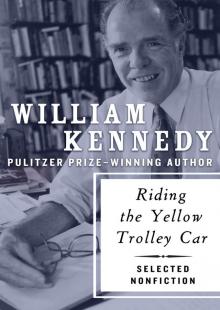 Riding the Yellow Trolley Car: Selected Nonfiction
Riding the Yellow Trolley Car: Selected Nonfiction Changó's Beads and Two-Tone Shoes
Changó's Beads and Two-Tone Shoes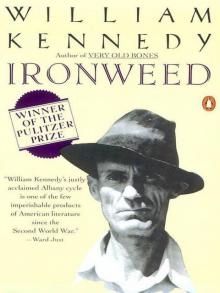 Ironweed
Ironweed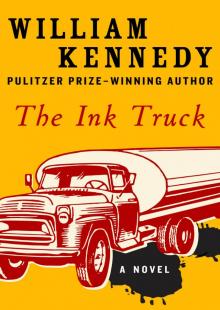 The Ink Truck
The Ink Truck Billy Phelan's Greatest Game
Billy Phelan's Greatest Game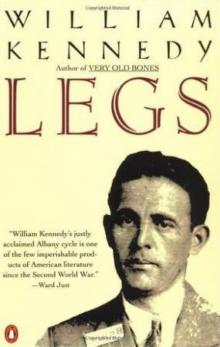 Legs
Legs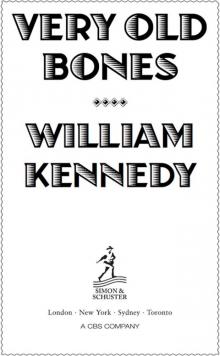 Very Old Bones
Very Old Bones The Last Mission
The Last Mission The Flaming Corsage
The Flaming Corsage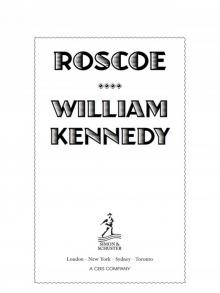 Roscoe
Roscoe Quinn's Book
Quinn's Book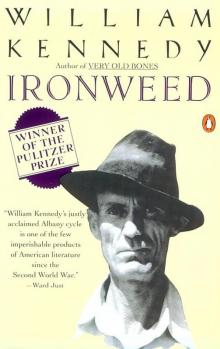 Ironweed (1984 Pulitzer Prize)
Ironweed (1984 Pulitzer Prize) Riding the Yellow Trolley Car
Riding the Yellow Trolley Car Legs - William Kennedy
Legs - William Kennedy